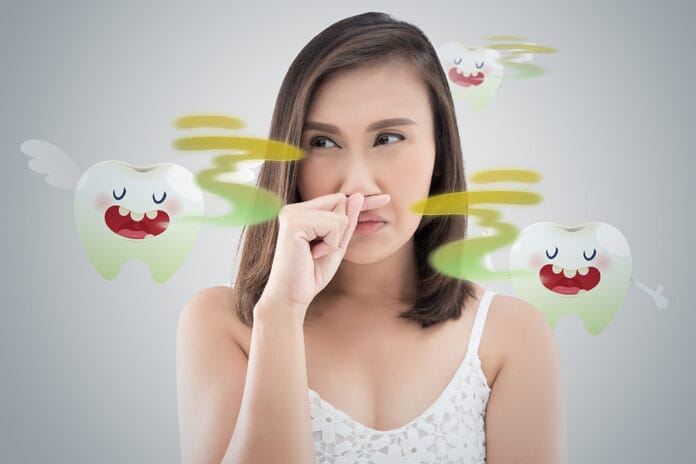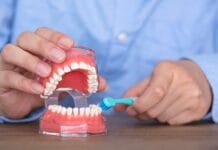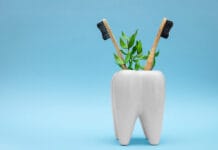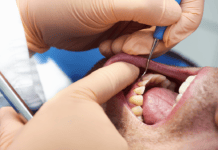Halitosis is a malodor that is expelled from the mouth. While everyone wakes in the morning with a less than desirable mouth aroma, some dental patients actually battle chronic bad breath on a daily basis.
One in four people experience bad breath, and some studies have reported as high as 50% of the adult population suffers from halitosis.1,2 In fact, it is estimated that nearly 60 million people will suffer from chronic halitosis in the United States.1,2 While commonly stemming from oral bacteria, halitosis may also be multifactorial, indicating a more serious issue.
What is Halitosis?
Halitosis is derived from the Latin word halitus (breathed air), and otis meaning pathological alteration.3 Halitosis is formed from volatile molecules such as sulfur compounds, aromatic compounds, nitrogen-containing compounds, amines, short-chain fatty acids, alcohols or phenyl compounds, aliphatic compounds, and ketones. Volatile sulfur compounds (VSCs) are mainly responsible for intraoral halitosis, with hydrogen sulfide and methyl mercaptan being the most common.4
The bacteria present in the mouth degrade organic substrates such as detained debris, glucose, and mucins to produce odorous compounds.
Physiological halitosis (morning breath) is caused by stagnation of saliva and putrefaction of entrapped food particles and desquamated epithelial cells by the accumulation of bacteria on the dorsum of the tongue or commonly known as tongue-coating.5
Halitosis Oral Culprits
Studies report that 80% to 85% of mouth malodors have intraoral causative factors, with the most important and common causes in the oral cavity being: lingual plaque (51%), periodontal disease (13%), or a combination of both (22%).5.6
Periodontal infections are responsible for a tremendous increase in gram-negative bacteria, increasing the amount of VSCs in the oral cavity. Notably, acute necrotizing ulcerative gingivitis (ANUG) creates a more distinguished malodor, one that most dental professionals have never forgotten. Poor oral hygiene, large carious lesions, xerostomia, wound infection at extraction sites, over-wearing of dentures at night are all contributing factors in halitosis.
Salivary flow plays a large role in halitosis as saliva aids and assists in buffering the mouth by keeping bacterial levels manageable. A reduction of saliva constitutes more plaque and opportunity for bacterial growth, thus increasing malodors. Reduced salivary flow can be attributed to many factors such as medicines, chemotherapy, radiation, or salivary gland disease (Sjogren’s). Those suffering from sleep apnea also have a reduced salivary flow due to mouth breathing/snoring. Therefore, sleep apnea is yet another factor in halitosis because of the lack of saliva.9
Naturally transient oral malodor may stem from volatile foods (those foods that change quickly into gas) such as garlic, onions, pickles, radishes, and condiments. Tobacco products can also leave behind malodors as they create an imbalance in the oral bacteria community. Coming as no surprise, bad breath may last for hours after the use or consumption of these items.
Non-oral Sources
While not as common, other factors may be responsible for malodors of the mouth. Ten percent of the oral malodor cases originate from the ears, nose, and throat region, from which 3% find its origin at the tonsils.5 When the tonsillar region is infected, a 10-fold increased risk of abnormal VSCs levels are present. Furthermore, bacteria stinks, and when a larger amount is present, a more prominent odor will be emitted. Tonsillar craters are also traps for food, bacteria, and mucins, which in turn can create tonsilloliths (tonsil stones) that also contribute to halitosis.
Sinusitis can create malodors as the stinky, infected mucins present in the sinus drips down the back of the throat meets the air that is exhaled. Less common than the aforementioned (but definitely a culprit), foreign bodies in the nasal cavity can create a malodor that is expelled through the airway.
Children often stick objects up their noses (such as paper or beans) that may become entrapped. The object can create an infection that, in turn, creates a bad odor on the breath.
Lung infections, bronchitis, antral and/or lung malignancy, or nasal sepsis are all upper respiratory issues that can be responsible for halitosis. During these upper respiratory problems, bacterial action is at play, causing putrefaction of the tissues or causes tissue necrosis and ulcerations, thus creating a production of malodorous gases by producing VSCs.4
Gastrointestinal disease can also be the culprit behind oral malodors. Pyloric stenosis, duodenal obstruction, diverticulitis, hiatal hernia, and pharyngeal pouches are all culprits for food retention, thus creating malodors. Reflux esophagitis, achalasia, and steatorrhea can create Helicobacter pylori infections causing VSC levels to increase in oral breath.4 Levels of VSCs in oral breath may be higher in patients with erosive than non-erosive oesophagogastro-duodenal mucosal disease.4
Hepatic diseases such as hepatic failure, renal failure, and diabetes (ketoacidosis) may all cause halitosis. Ketoacidosis is life-threatening and occurs when the body starts breaking down fat at a rate that is much too fast, thus creating ketone buildup in the blood. One of the first symptoms of this potentially fatal condition is a “fruit-scented” breath.7 Others may complain of a “corn-scented” breath.
Patients with chronic kidney disease have kidneys that aren’t efficient in removing waste from the body, such as urea. Urea is typically removed from the body through the urine. However, when there is an excess buildup of urea, the body then finds other means of expelling it, such as pushing it through the breath. When the excess urea in your body reacts with saliva, it forms ammonia and produces a malodor called uremic fetor.8
Dental Professional Guidance
When patients complain about bad breath, dental professionals (especially dental hygienists as the topic is often discussed at prophylaxis appointments) are given an opportunity to sniff out the source. With radiographs and an examination, a broader look into the possible culprit can be discovered. Questioning the patient on the frequency, occurrence, and severity will also help to narrow down the malodor source. Remember to be aware of oral malodors that might not be as offensive but are still indicative of a systemic issue.
This conversation sets the stage for proper oral hygiene and routine maintenance guidance. Advising patients to clean interdentally, brush, clean their tongue, use oral probiotics, and visit their dentists for routine maintenance are all ways to help eliminate or reduce typical halitosis.
Dental professionals get the best (or not so best) front seat in breath sniffing. Working in close proximity to the mouth comes with some disadvantages, but it also allows us to be part of the link to health care, an opportunity to assist our patients with more than their dental health. Patients often complain of bad breath, and while it often has oral manifestations, it can run deeper than the oral biome.
As dental professionals, this is a great opportunity to ask questions, decipher the root of the cause, and make recommendations for medical referrals, when necessary, after no apparent oral link to halitosis is evident. Never underestimate your role as a dental professional, and, when avenues present to help better the overall health, take them!
Now Check Out the Peer-Reviewed, Self-Study CE Courses from Today’s RDH!
Listen to the Today’s RDH Dental Hygiene Podcast Below:
References
- Bad Breath: Do You Have It? (2009). Colgate Professional. https://www.colgateprofessional.com/patient-education/halitosis/bad-breath-do-you-have-it
- Downs, R. (2010, April 26). Bad Breath. American Breath Specialists. http://www.breath-care.com/cause.html
- Hine, K.H. Halitosis. 1957; 55: 37–46.
- Aylıkcı, B.U., Colak, H. Halitosis: From diagnosis to management. Journal of Natural Science, Biology, and Medicine. 2013; 4(1): 14-23. doi:10.4103/0976-9668.107255.
- Kapoor, U., Sharma, G., Juneja, M., Nagpal, A. Halitosis: Current concepts on etiology, diagnosis and management. European Journal of Dentistry. 2016; 10(2): 292-300. doi:10.4103/1305-7456.178294.
- dos Santos Romero, S., Oppidoa Schalch, T., Llanos do Vale, K., et al. Evaluation of halitosis in adult patients after treatment with photodynamic therapy associated with periodontal treatment. Medicine. 2019; 98(39): e16976. doi: 10.1097/MD.0000000000016976.
- Diabetic Ketoacidosis – Symptoms and Causes. (2020, November 11). Mayo Clinic. www.mayoclinic.org/diseases-conditions/diabetic-ketoacidosis/symptoms-causes/syc-20371551
- What Is Ammonia Breath and Is It a Symptom of CKD? (n.d.). Fresenius Kidney Care. https://www.freseniuskidneycare.com/thrive-central/ammonia-breath
- Tullo, V. (2019, April 1). There’s a Correlation between Bad Breath and Sleep Apnea. Humanitasalute. https://www.humanitas.net/health/magazine/3373-theres-correlation-bad-breath-sleep-apnea.












